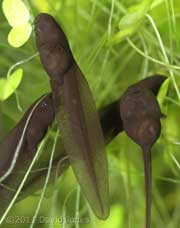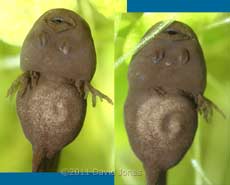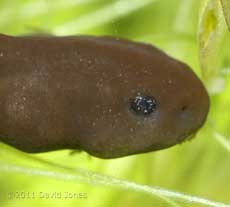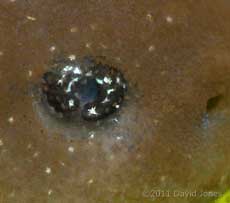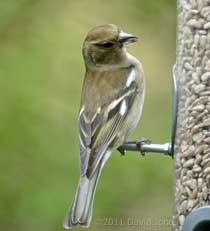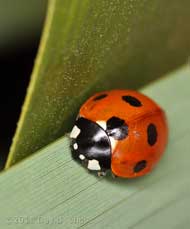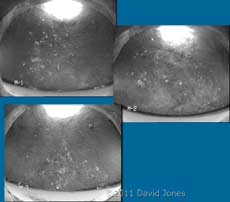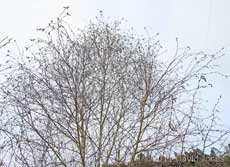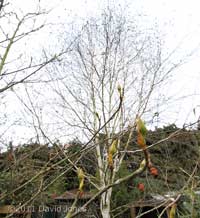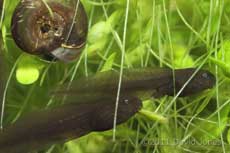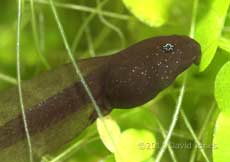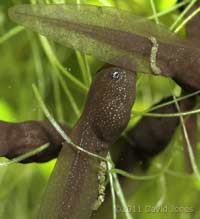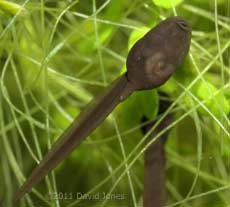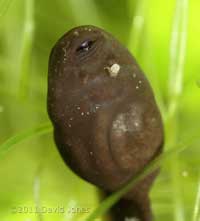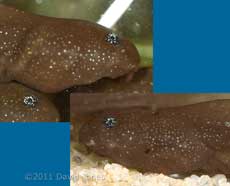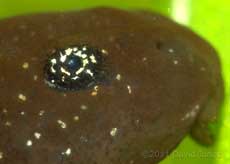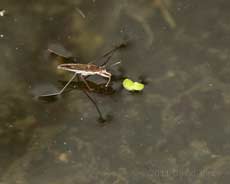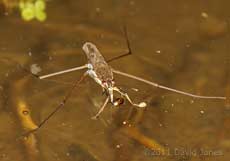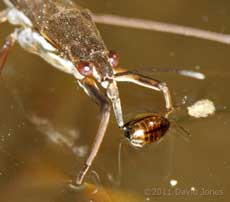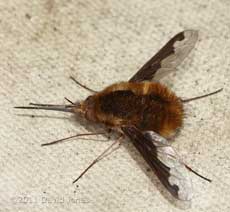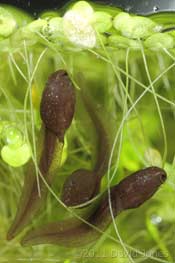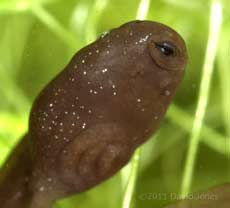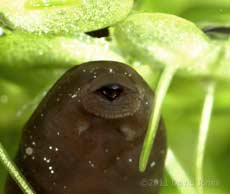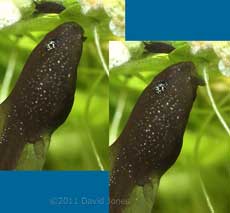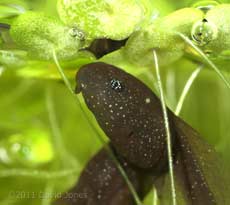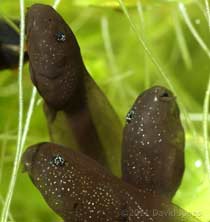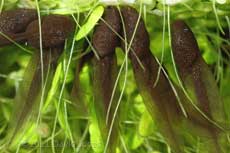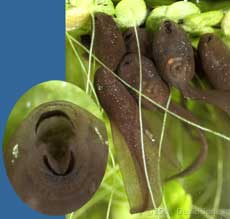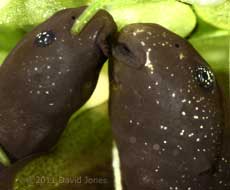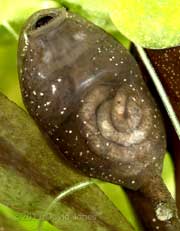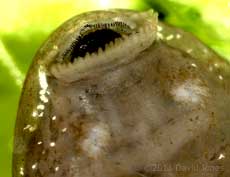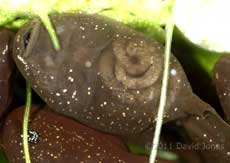Go to the last entry on this page .....Go to previous entry1 April - A day on which the sun played the fool with us, only appearing momentarily from time to time, leaving us with grey skies for nearly all the time - at least it remained dry with the temperature up to around 15C which meant that I was able to spend time outside treating some wood with preservative (the varnishing is over , for the time being at least!). While I had paintbrush in hand the Great Tit male arrived in the garden, perched atop out Birch tree and sang/called loudly of several minutes. I fell for the joke and rushed to the nest box to remove the straw. Checking the cctv recording at the end of the day confirmed that no bird even looked in, but there was a single visit by a Bumble Bee at around 12.30pm. I was just setting up my kit to photograph the tadpoles when my grand-children arrived and so the afternoon flew by. Erin inspected the tadpoles and then headed for the pond to spot frogs. As has been the case for her last couple of visits, it was cloudy and there was not a frog to be seen! While that was a disappointment, as we got back to the veranda she had a different treat in the form of the loud calls of the male Chaffinch from in the Hawthorn. We sat on the floor and kept still and quiet (she's very good at doing that!) and listened for a minute or so. Unfortunately it was clear that with us in sight he wasn't going to come to the feeder. We crept back indoors and just as we got to the patio window it arrived - Erin's first good look at a Chaffinch. Although she didn't see it, I also spotted a female Chaffinch in the Hawthorn for the first time this year. It stayed away from the feeder and followed the male as soon as he left.
Anyway, once Erin and the rest of her gang left I took just a few pictures to record the tadpoles' progress.
There are no scales to accompany today's pictures but measurements of a number of tadpoles suggest that they remain between 12-13mm in length.
This pair are clearly less well developed, with the left hand tadpole having both sets of external gills well exposed. Notice the swirl under the abdomen, indicating the position of the digestive tract.
(added 5 April) - The opercular folds that are growing back to cover the gills, and which are now continuous with each other, are gradually engulfing the external gills to form a gill chamber. By now, gill slits will have definitely opened up inside the chamber, sets of four on each side, which link the tadpole's pharynx with the gill chamber. These are developing gill structures to replace the external gills. The latter rely on simple diffusion of oxygen in and are inefficient for the increasingly active tadpole. Once development is complete the tadpole will be able to take in water through the mouth/nostrils and force it over the internal gills which are protected by the covering of the gill chamber.
Finally, turning to the developing eyes, these are now much more obvious on many of the tadpoles, along with the small white flecks that you can see here and on one of the tadpoles in the first picture.
And if you look much more closely to can see more detail and a definite lower edge. I cannot decide if the white flecks are the result of reflections, although they occur on the skin of the tadpole as well as its eye. I have yet to find a description of the structure of a tadpole's eye.
2 April - A dry day on which the promise of a sunny afternoon failed to materialize. The day started with a breakfast time temperature around 13C, rising to 17C by 2pm, only to drop a few degrees during the afternoon as the cloud cover thickened. Yesterday I mentioned seeing a female Chaffinch here for the first time. Well, this morning the pair were here 'for breakfast'. The male was first to the feeder with the female only visiting after he had returned to the Hawthorn. Her stay was brief, with just enough time to grab a couple of quick shots before the pair left. I should have mentioned this before, but I haven't seen a Siskin at all this past week - they seem to have moved on.
Later in the morning I came across my first Ladybird of the year, a 7-spot Ladybird. I wonder what the ratio of native species to Harlequins in the garden will be in 2011.
Over the last few days I've been reading reports that House Martins have started returning to the UK. I know that our boxes have remained unused for the last few years but these reports spurred me into giving the artificial House Martin nests a Spring clean this morning now that there is no longer a Sparrow roosting in any of them.
The first job was to use a vacuum cleaner (from my workshop, rather than the house) and a narrow tube to remove the droppings from nests 1 and 3. The camera in Nest 2 had a focusing problem so I needed to remove that nest, make the necessary adjustments and then replace it. As usual, I sealed around the edges with mud made from worm droppings (chosen as conveniently they will have been finely sieved by the worms!).
I'm afraid there are no tadpole picture today. After the Martin nests were back in order, the ladder was put away, I cleaned up and we headed off to a delicious lunch with another one of our sons and his lovely wife, spending the rest of the afternoon with them.
3 April - Another day when the promise of sunshine was short-lived. The temperature peaked at 14C around lunchtime before dropping a couple of degrees as the afternoon progressed. This was going to be another day when we would be away from home and in the morning I needed to do a few jobs before we left. However, I did get a step ladder out to help record an event at the bottom of the garden. First, we have now entered the tree pollen stage of the hay fever season. Itchy eyes reward every excursion outside, and I guess that having a Birch tree in the garden doesn't help.
I see that the uppermost male catkins are now swollen up and must be shedding their pollen. I must try to get some closer photographs - no time today.
Within range of my ladder are the lower branches of the Rowan, and on those the first buds are now bursting.
It always seems amazing to see how the young leaves (and flower buds) are packed into the space enclosed by the bud's cap, and how quickly they start springing apart once it has been shed.
We spent the afternoon with grand-daughter Erin and her family, being treated to the second delicious meal in two days, with the added bonus this time of having Erin to entertain us! Once lunch was cleared away we headed out into the garden and the two of us ended up on our knees digging for earthworms! Much more fun was the millipede that she enjoyed watching as it tickled her hand! Remembering that yesterday I saw the first ladybird in our garden I set out to find one in Erin's garden, but without luck - I blamed it on the lack of sunshine. However, while I was helping Erin to ride her bicycle she suddenly shouted at me to stop. She jumped off the bike and dashed back to to where her mum had planted some Strawberry plants, kneeled down and picked up a 7-spot Ladybird - she had succeeded where I had failed, and wasn't she pleased..... It was shown to everyone and then returned to the same spot. Back home after a great afternoon I put my feet up for a while before remembering the tadpoles. The trouble with leaving them, even for a single day, is that changes take place so quickly with no second chances (until next year).
The most obvious things to note from this picture are the brightly speckled eyes, and perhaps more dramatic, the complete absence of the external gills.
Not only have the gill disappeared, but also the pouch of skin that was starting to envelop them two days ago is no longer visible. This tadpole was busy grazing on the duckweed leaf, or rather on algae that would be present on its surface.
And of course, now that they are feeding the tadpoles are also producing waste.
Opportunities to see their undersides were few and far between, but as you can see here the mucus glands are now little more than remnants.
They can be seen more clearly in this closer shot. It seems that there may be a little mucus still present, judging bit the bit of debris clinging to the tadpole. I mentioned above about how the skin fold had disappeared, but in this picture I think it is just possible to see where it is. Look carefully at the right side and you may just make out a curved line which starts where the edge of the body outline is 'pinched in'.
I wasn't able to get a really close shot of an eye today, but from the pictures I took it was obvious how clearly they now show up, especially with those white flecks present. While they are concentrated around the eye, they occur in the skin as well,
although it is the flecks around the eye that reflect the light most. The pattern varies from tadpole to tadpole. I wonder if there is a specific purpose behind their presence.
A check through the day's cctv recording revealed that during the morning there was increased activity by the Sparrows, mainly visiting SW-up and SW-lo but also all three House Martin nests - they must have realised that someone had cleaned them out! On one occasion there were two Sparrows in HM-1 - it will be a heck of a squeeze if they were to nest in there! At 12.33pm there was a face at the entrance to the Great Tit box. It was difficult to be sure, but I think it was a Great Tit.
4 April - A bright and breezy day, much better, but although the winds came from the south south west, wind speeds of up to 22mph during the afternoon kept the temperature down. The high was 13C. I needed that breeze to help me wake up today. After the weekend's activities the day had a very slow start for me, and it was not long before noon when I first set foot outside!
Anyway, it wasn't long before I headed back indoors to grab my camera in order to record the first Pond Skater seen this year.
A bit later I photographed it again, this time in the middle of a meal (the change in image colour was due to the sun coming out!). I couldn't quite make out what its victim was,
but I wasn't able to get closer without it dashing off across the pond. This is a cropped version of the same photograph. When I have more time I may take another look at the original image and try an identification.
As the prospect of getting 'good weather days' improves I'm trying to organise things ready for out-door play. After varnishing the surround for a sand box last week, this afternoon I set it up and added a rain cover.
I was just marking the positions for some eyelets on that cover when a Bee-Fly landed on it. I think I caught a glimpse of one yesterday, but this is the first sighting that I can be certain of. It remained in place, sunbathing, while I collected my camera and take this picture, but left the moment I was clumsy enough to allow my shadow to pass over it.
The tadpoles were more active than ever today, providing an increasing challenge. However, I've been able to answer a couple of my own questions about the changes they are undergoing. Their time seemed to be divided between churning up the organic matter on the bottom of the tank, and heading up to graze on the duckweed, and I decided to concentrate on the opportunities offered by the latter activity.
In this first close-up you can see how the mucus glands have now all but gone, and just above the coiled abdomen you can just make out a line that must mark the position of the fold of skin seen earlier. As was the case in my pictures yesterday there is no sign of the gills - I'll come back to that later. The first question to be answered today concerned the rasping teeth that I had yet to see. My first opportunity to actually see them came with this close-up. Look closely at the top edge of the lower 'lip' and you can see something rough.
However, in this second example I think there is little doubt as to whether or not these are the teeth. They were visible even without any enhancements of the image!
When the tadpoles swim up to the duckweed, in order to graze on the undersides of the leaves they frequently roll over to make the grazing easier. While this tadpole didn't do that, these successive frames show it extending the lower mouth parts ready to use those rasping teeth.
The second question that I wanted to answer regarded what happened to the gills once the external gills had disappeared, as all the pictures above seem to indicate. I knew that the external gills are replaced by internal ones, but yesterday I saw no sign of these. However, the answer came with first with this photograph, showing a small D-shaped opening on the tadpole's side. As the session progressed I saw more examples of the gill being open, but obviously it must be opened and closed as part of a pumping action to deliver fresh, oxygenated water to the gills. In my nest session I must try to take a sequence of picture of this happening on a tadpole.
In the meantime, this trio of tadpoles show, the one on the right with the gill closed, and open on the lowest tadpole. The individual at the top of the image has a longer indentation suggesting that it may not be quite as far advanced in this respect as the other two.
5 April - A dull, damp start to the day and although it soon dried up the cloud cover remained complete past dusk - glum, with a maximum temperature of 12C. Not surprisingly, there was very little activity seen in the nest boxes today, and what there was had ended by 10am. There was little activity on my part today too after not being able to get to sleep last night. At 2am I was eating a lemon curd sandwich (delicious) while watching Major League Baseball!
A glance at the tank doesn't show much progress in the last 24 Hours, the tadpoles fluctuating between time spent churning up the bottom of the tank and heading up to graze on the duckweed. Spotting the gill opening continues to be more miss than hit.
However, the rasping teeth and definitely more in evidence today, and in this shot I was lucky to catch one tadpole with its mouth wide open, showing both upper and lower teeth. It's a pity I didn't catch this moment at a higher magnification.
One interesting aspect of the tadpole design is that the position of the eyes is clearly not to se what it is eating as they are too much to the side of the head, where they are better placed to watch out for predators. It does mean that the tadpole apparently feels/tastes its way around possible sources of algae. This 'kiss' is simply one tadpole testing another as that search goes on.
Its semitransparent skin reveals not just the coil of the abdomen but also the gill chamber, situated just in front of it - look for the curved outlines, and inside the remnants of the external gills. I've just read that the fold of skin that developed a few days ago created a single, common gill chamber. The skin has fused along the posterior edge, sealing the cavity apart from a single gill opening (or spiracle) on the left side of the tadpole. This accounts for the opening not showing up on at least half my pictures!
As a result of re-reading my old 6th form textbook in conjunction with what I've seen over the last week, I've gone back through my notes to make a few amendments to the sections that refer to the external gills and their 'disappearance' - on 28, 30, 31 March, and 1 April.
The same picture also provided the best image so far of the rasping teeth along the top of the mouth. Notice how two light coloured patches are now the only indications of where the mucus glands were situated.
This second shot of the same tadpole also shows the details described above, but I'm actually including it to give an idea of the extent of colour variation that is present amongst the tadpoles.
Click on images to see larger version
|
|
2011 Garden Diary Index..... ...Last Month..........April (part 2) |
